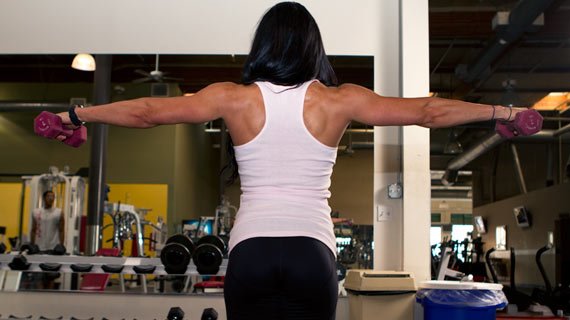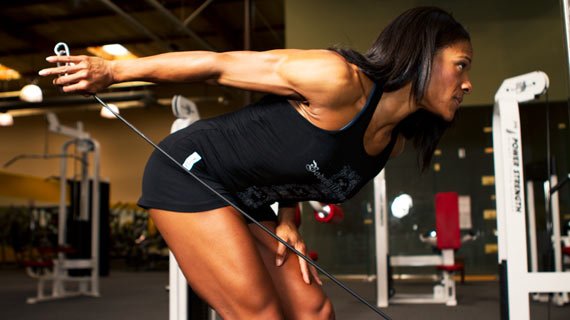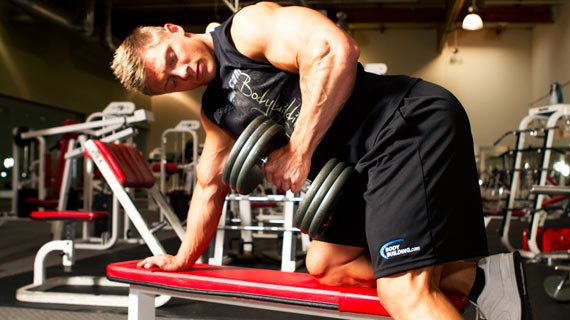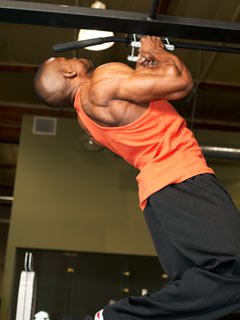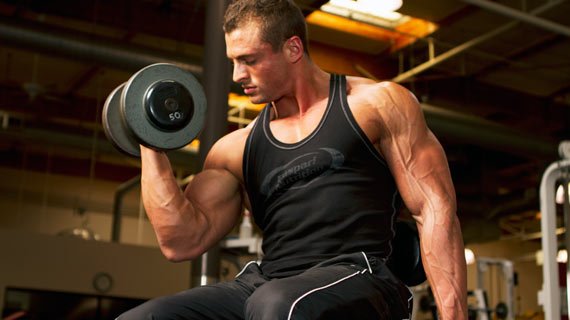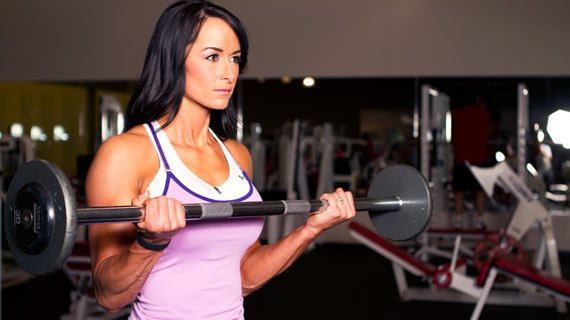Don't get me wrong: I am grateful for my 20 years of bodybuilding training. I wouldn't want anyone to think otherwise. I packed a lot of muscle mass on my puny frame.
However, as I aged, my training stagnated. It went stale like bread during a carb fast, so my goals changed from getting "swoll" to staying conditioned.
I no longer wanted to be "just big." Big wasn't good enough. I wanted to be functional and athletic as well.
As I started to change my training, I still had habits from years of bodybuilding I needed to break. These habits were not necessarily bad; they helped me amass muscle and carve shape. However, as I transitioned out of bodybuilding to athletic training, these old habits held me back.
Paradigm Shift
For those of you who tire of the "stuffing protein down your throat" lifestyle, these old bodybuilding habits might hinder you as well. We train for various reasons, but in the long run most of us want to have a better body.
If your old habits now hurt this goal, it's time to discard them. Move forward with an open mind. These 3 solutions will lead to the best shape of your life.
Old Habit 1: Slow Movements
New Solution: Explosive Tempo Training
For many years, I lifted weights at a slow speed so I could feel continuous tension on the muscle. The concept was simple - if I can feel my muscles, they will grow more. For extra variety, I would sometimes go into super slow-motion mode and methodically raise and lower the weight with a 10-second count.
How wrong I was.
One problem I have with slow movements is that you usually don't go heavy. I would often lift with very light weights. (I'm embarrassed to say how light [or pink] the dumbbells actually were). Also, slow-tempo movements don't recruit the maximum number of motor units. Instead, you use your slow-twitch muscles, the smallest and hardest to grow muscle group. Slow lifting generally doesn't translate to sport performance.
When was the last time you saw an athlete deliberately crawl like a snail? I can't imagine a baseball player swinging a bat slowly to hit a home run, or an MMA fighter throwing an extra-slow roundhouse kick so he can feel the continuous tension of his leg. Most athletic movements are explosive, ferocious and fast.
It's not surprising that explosive athletes generally have the best body compositions, looking ripped, dangerous and lethal. From any angle, explosive athletes look like they can kick your ass very fast. This is the definition of explosive power - the ability to apply dominating force very quickly.
So instead of trying to trying to look huge, my new aesthetic goal became to attain this "elite athletic body."
Explosive Intent
To look like an explosive athlete, you have to learn to generate rapid force. No more slow stuff or tiny weights. Instead, you lift heavy and you lift fast. When you move a load explosively, you recruit your fast-twitch muscles, the big muscles in your body that grow the most and contract the hardest.
It's the not the literal speed of the movement, but the intent to move fast that's incredibly important. You want to bring the heat! With the intent to apply force as fast as you can, explosive lifting recruits certain muscles that don't get used unless you move with maximum effort. The more muscles you use in any movement, the stronger you will be. And we know what happens when you get stronger - you start packing on some serious muscle.
You can apply a faster lifting tempo to all your exercises. The only movement you want to be extra careful with is the deadlift. You don't want to lift the bar off the ground too fast, which can cause too much strain on your back. So, instead of jerking the bar off the ground, start slow and, when the bar passes your knees, drive your hips as fast as you can.
With the rest of your movements, concentrate on faster concentric lifting.
The best part of training with increased speed is that it raises your workout intensity. The intensity of the work heightens your natural release of more testosterone and HGH. These free-flowing hormones can help support muscle building.
Lifting with speed elevates your metabolism and burns more calories both during and after your workout. A revved up metabolism puts your body in a fat-burning mode so you can burn more fat for up to 48 hours after you're done training.
Start transforming your physique into that of a well-trained explosive athlete. Ditch the slow stuff and lift with some serious speed. You'll jack up your power and look more bad ass than ever.
Old Habit #2: Mirror, Mirror On The Wall
New Solution: Turn Your Back
It's easy to get mesmerized by your own muscles, especially while training. We get to watch ourselves grow in the mirror, which is insanely motivating. As inspiring as it is to focus on your reflection, it can become a huge distraction - especially when you lift explosively.
Looking at yourself will interfere with your speed and slow down your movement. It may be a fraction of a second, but that tiny amount of time can have a huge impact when you're trying to become an explosive athlete.
Don't let your vanity vanquish your speed, force or precision. Look away from the mirror when you train. If you're worried about your form, have a friend film or coach you.
We are trying to emulate how elite athletes train, and the last time I looked, there's no mirror in the octagon - or anywhere near the boxing ring, mountain, baseball diamond, football field, basketball court or track. Only in your typical commercial gym do you see a house of mirrors.
Escape the fun house!
Break the Chain
Mirror training can cause serious imbalances. Most people only train the muscle groups they can see - their chest, biceps, quads and abs. Frontal training is dominated by the masses. As a result, the back-of-body muscles - like your traps, back, glutes, hamstrings and calves - go underdeveloped.
Elite athletes train the back side (posterior chain) in order to catapult with explosive force. Power athletes are back-dominant, while the general population is front-side oriented. This is the major problem with the aesthetic-oriented training of the masses. You may look good, but you lack the potential of launching explosive action due to an untouched posterior chain.
I know most of you could care less about having a strong posterior chain, but big traps and a wide back, tight glutes, and huge hamstrings will give you that "scary look" - the look that shows you can wipe somebody out very quickly.
Train what you can't see. Deadlifts, pull-ups, good mornings, sled pushes - all these movements attack muscle groups you cannot see while training; they beef-up your posterior chain.
If you want to see what you look like, wait until after your workout. After a couple of months using this new habit, I'm sure you'll like what you see and you can admire yourself as long as you want.
Old Habit #3: Tensing the Target Muscle
New Solution: Total Body Tension
One of the oldest habits I had to break was isolation training. For years, single-muscle training taught me to tense only the muscle group I was using, even if it was a huge compound lift.
For example, if I was training my shoulders with military presses, I would focus on tensing my delts while ignoring the rest of my body. The major flaw of only tightening one muscle group is that you fail to use your other muscles to assist in the lift.
Studies show that you can increase weight lifted by up to 30% if you use multiple muscle groups when moving a load! By using only one muscle group, you're not working at full strength.
The goal of the explosive athlete is not to bulk up, but to recruit as many muscle groups to fire at the same time. Muscle groups are linked together. They are a kinetic chain and each link needs to be in sync. Only by learning to use your whole body as one unit instead of individual body parts will you ever develop true strength.
The best way to learn how to recruit muscle groups is to tighten as many muscle fibers as possible before you begin a lift. For example, when I get ready to do military presses, the first thing I do is grab the bar and squeeze as hard as I can. Doing so, I activate my forearms and biceps.
I then flare out my lats to engage them and brace my abs as hard as possible, as if somebody is going to hit me. While I press the bar up as fast as I can, I squeeze my glutes and tighten my legs. As I finish the movement and hold the bar over my head, I make sure my shoulders are tight.
As I lift, I activate all my muscle groups as one machine. And handling heavier loads leads to a better body composition. Again, the key factors are activating as much muscle and getting as tight as possible before the lift. If you wait to tense your whole body until after you pick up the weight, it will be too late.
You must be tight and tense for the setup, especially in your core. A tight core keeps your spine in a neutral position and stabilizes your body for the shock of the heavy load. If you are going to do a heavy deadlift or squat without bracing your core, the shock of the heavy load may cause your spine to shift away from the neutral position to a hyper-extended curve.
You never want to have a hyper-extended or over-exaggerated arch in your lower back, which can lead to serious back problems. Just remember that the external pressure of the heavy load must match the internal pressure in your body, so stay as tight as you can, especially in your core!
Secret Strength
Maintaining a high level of tension throughout your body is the secret of gymnasts, powerlifters and Olympic lifters. It is a skill that requires practice and can be applied on all your movements. It doesn't matter if you're doing curls or bench presses - tense your entire frame before you begin the movement.
You can practice this whole body tension method when you're away from the gym, too. The next time you're standing in line or walking, contract as many muscle groups as you can. The more you do it, the more familiar your body will be with total tension.
As you progress, you will immediately notice which areas in your body are loose. You don't want any weak links in your body, especially during a heavy lift or explosive movement. If one area is not tight, your body will compensate and you will not be at full strength.
Learning to produce and harness tension throughout your body will help you develop your strongest and leanest physique possible.
Change Is Good
Changing old habits and trying new things can be difficult. As we tire of failing to make progress, we must make drastic changes in our training.
Lifting with speed, recruiting more muscle groups and tensing the body are three things you can do to effectively force your body to grow. This is how explosive athletes train.
Emulate their training habits and you will transform your body into a fast-twitch muscle machine.

